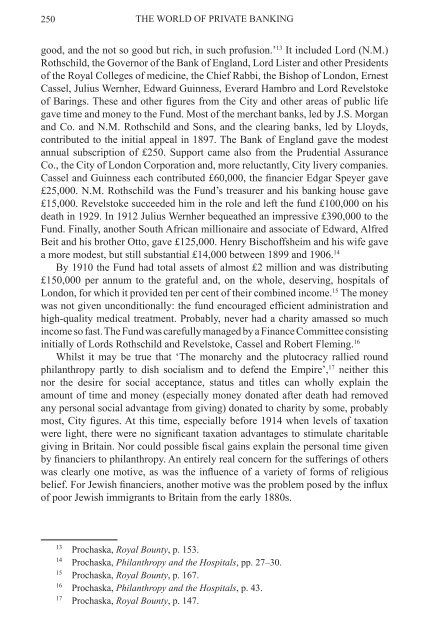the world of private banking
the world of private banking
the world of private banking
You also want an ePaper? Increase the reach of your titles
YUMPU automatically turns print PDFs into web optimized ePapers that Google loves.
250<br />
THE WORLD OF PRIVAtE BANKING<br />
good, and <strong>the</strong> not so good but rich, in such pr<strong>of</strong>usion.’ 13 It included Lord (N.M.)<br />
Rothschild, <strong>the</strong> Governor <strong>of</strong> <strong>the</strong> Bank <strong>of</strong> England, Lord Lister and o<strong>the</strong>r Presidents<br />
<strong>of</strong> <strong>the</strong> Royal Colleges <strong>of</strong> medicine, <strong>the</strong> Chief Rabbi, <strong>the</strong> Bishop <strong>of</strong> London, Ernest<br />
Cassel, Julius Wernher, Edward Guinness, Everard Hambro and Lord Revelstoke<br />
<strong>of</strong> Barings. These and o<strong>the</strong>r figures from <strong>the</strong> City and o<strong>the</strong>r areas <strong>of</strong> public life<br />
gave time and money to <strong>the</strong> Fund. Most <strong>of</strong> <strong>the</strong> merchant banks, led by J.S. Morgan<br />
and Co. and N.M. Rothschild and Sons, and <strong>the</strong> clearing banks, led by Lloyds,<br />
contributed to <strong>the</strong> initial appeal in 1897. The Bank <strong>of</strong> England gave <strong>the</strong> modest<br />
annual subscription <strong>of</strong> £250. Support came also from <strong>the</strong> Prudential Assurance<br />
Co., <strong>the</strong> City <strong>of</strong> London Corporation and, more reluctantly, City livery companies.<br />
Cassel and Guinness each contributed £60,000, <strong>the</strong> financier Edgar Speyer gave<br />
£25,000. N.M. Rothschild was <strong>the</strong> Fund’s treasurer and his <strong>banking</strong> house gave<br />
£15,000. Revelstoke succeeded him in <strong>the</strong> role and left <strong>the</strong> fund £100,000 on his<br />
death in 1929. In 1912 Julius Wernher bequea<strong>the</strong>d an impressive £390,000 to <strong>the</strong><br />
Fund. Finally, ano<strong>the</strong>r South African millionaire and associate <strong>of</strong> Edward, Alfred<br />
Beit and his bro<strong>the</strong>r Otto, gave £125,000. Henry Bisch<strong>of</strong>fsheim and his wife gave<br />
a more modest, but still substantial £14,000 between 1899 and 1906. 14<br />
By 1910 <strong>the</strong> Fund had total assets <strong>of</strong> almost £2 million and was distributing<br />
£150,000 per annum to <strong>the</strong> grateful and, on <strong>the</strong> whole, deserving, hospitals <strong>of</strong><br />
London, for which it provided ten per cent <strong>of</strong> <strong>the</strong>ir combined income. 15 The money<br />
was not given unconditionally: <strong>the</strong> fund encouraged efficient administration and<br />
high-quality medical treatment. Probably, never had a charity amassed so much<br />
income so fast. The Fund was carefully managed by a Finance Committee consisting<br />
initially <strong>of</strong> Lords Rothschild and Revelstoke, Cassel and Robert Fleming. 16<br />
Whilst it may be true that ‘The monarchy and <strong>the</strong> plutocracy rallied round<br />
philanthropy partly to dish socialism and to defend <strong>the</strong> Empire’, 17 nei<strong>the</strong>r this<br />
nor <strong>the</strong> desire for social acceptance, status and titles can wholly explain <strong>the</strong><br />
amount <strong>of</strong> time and money (especially money donated after death had removed<br />
any personal social advantage from giving) donated to charity by some, probably<br />
most, City figures. At this time, especially before 1914 when levels <strong>of</strong> taxation<br />
were light, <strong>the</strong>re were no significant taxation advantages to stimulate charitable<br />
giving in Britain. Nor could possible fiscal gains explain <strong>the</strong> personal time given<br />
by financiers to philanthropy. An entirely real concern for <strong>the</strong> sufferings <strong>of</strong> o<strong>the</strong>rs<br />
was clearly one motive, as was <strong>the</strong> influence <strong>of</strong> a variety <strong>of</strong> forms <strong>of</strong> religious<br />
belief. For Jewish financiers, ano<strong>the</strong>r motive was <strong>the</strong> problem posed by <strong>the</strong> influx<br />
<strong>of</strong> poor Jewish immigrants to Britain from <strong>the</strong> early 1880s.<br />
13<br />
Prochaska, Royal Bounty, p. 153.<br />
14<br />
Prochaska, Philanthropy and <strong>the</strong> Hospitals, pp. 27–30.<br />
15<br />
Prochaska, Royal Bounty, p. 167.<br />
16<br />
Prochaska, Philanthropy and <strong>the</strong> Hospitals, p. 43.<br />
17<br />
Prochaska, Royal Bounty, p. 147.












![[Pham_Sherisse]_Frommer's_Southeast_Asia(Book4You)](https://img.yumpu.com/38206466/1/166x260/pham-sherisse-frommers-southeast-asiabook4you.jpg?quality=85)



